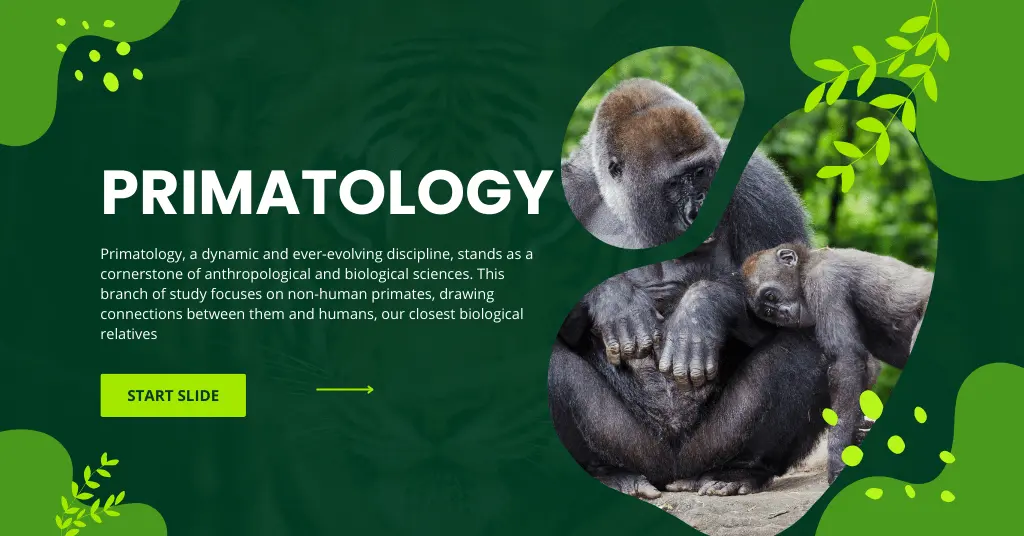AI Answer Evaluation Platform Live Now. Try Free Answer Evaluation Now
Primatology
Primatology, a dynamic and ever-evolving discipline, stands as a cornerstone of anthropological and biological sciences. This branch of study focuses on non-human primates, drawing connections between them and humans, our closest biological relatives [1]. This journey into the world of primates serves multiple purposes, primarily granting us a deeper understanding of human evolution, aiding in conservation efforts, and enhancing our knowledge base regarding global health and animal rights.

Primate Research – A Window into Human Evolution
Molecular evidence supports the claim of our shared lineage with non-human primates, with a remarkable 98.7% genetic sequence similarity between humans and chimpanzees [2]. This striking kinship illuminates many aspects of human biology and physiology, ranging from our immune system’s architecture to the scaffolding of our cognitive capacities.
Additionally, observations of primate behavior and social structures provide a theoretical basis for understanding evolutionary pressures that might have shaped our human ancestors. Behavioral characteristics shared across primate species, like group living, tool use, and cooperative behavior, provide pivotal insights into the evolutionary trajectory of Homo sapiens [3].
Conservation Implications of Primatology
Many non-human primate species face the grim reality of endangerment due to myriad threats, including habitat loss, illicit pet trade, and disease transmission. As primatologists delve deeper into primate ecology and behavior, they can propose effective conservation strategies tailored to protect these species and their habitats. Thus, primatology emerges as a critical ally in our endeavor to safeguard Earth’s biodiversity.
Primatology – A Vanguard of Animal Rights
The heightened cognitive abilities and emotional depths of our primate relatives have prompted an increased focus on animal rights, advocating for their welfare. Primatological research plays a crucial role in these discussions, steering improved regulations in research ethics and zoological practices [4]. Thus, primatology transcends its academic boundaries, offering a firm foundation for ethical considerations regarding our fellow beings.
Global Health – Primatology’s Contribution
Primates often serve as reservoirs for diseases with potential to leap into human populations, evidenced by HIV/AIDS and potentially even COVID-19. Primatology, through its exploration of primate ecology, behavior, and genetics, can help predict and prevent future pandemics, thus significantly contributing to global health endeavors.
In essence, primatology, with its far-reaching implications, remains an indispensable component of anthropological science. By unearthing deeper truths about our primate relatives, we simultaneously uncover more about ourselves, shaping a clearer understanding of our place within the natural world.
Primate Classification and Evolution:
Primatology, an intricate sub-discipline within anthropology, allows us to delve into the rich spectrum of primate species through taxonomic classification and evolutionary history. This exploration, which includes ourselves as a primate species, illuminates our comprehension of life’s interconnected nature and offers insights into our unique evolutionary trajectory.
Primate Classification – An Overview
Primates are an order of mammals encompassing over 500 species, divided into two distinct suborders: Prosimii and Anthropoidea [5].
The Prosimii, or ‘lower primates’, comprise lemurs, lorises, and tarsiers. These small, primarily nocturnal and arboreal creatures inhabit regions of Madagascar, Africa, and Southeast Asia [6].
On the other side, the Anthropoidea, known as ‘higher primates’, include monkeys, apes, and humans. Monkeys are further bifurcated into New World (Platyrrhini) and Old World (Cercopithecidae) monkeys, based on their geographic distributions in the Americas and Afro-Eurasia, respectively. The Hominoidea, or apes, which includes gibbons, orangutans, gorillas, bonobos, chimpanzees, and humans, are noted for their tailless bodies, larger sizes, and complex social behaviors [7].
The Evolutionary Saga of Primates
As we traverse the annals of primate evolutionary history, we rely on fossil evidence and genetic data to weave a tale that commenced approximately 65 million years ago (mya).
Around 55 mya, we see the emergence of early prosimians, characterized by key evolutionary traits such as grasping hands and feet, forward-facing eyes enabling stereoscopic vision, and a relatively larger brain to body size ratio compared to other mammals [8].
By 40 mya, anthropoids, with an even larger brain size, heightened reliance on vision, and complex social structures, marked a significant evolutionary transition [8].
The divergence between New World and Old World monkeys occurred around 35-40 mya, with features like the prehensile tail in many New World species and variations in nasal morphology setting them apart.
The following table summarizes these significant milestones in primate evolution:
| Evolutionary Event | Estimated Time (Million Years Ago) | Key Traits Developed |
| Appearance of prosimians | 55 | Grasping limbs, forward-facing eyes, larger brain-to-body size ratio |
| Appearance of anthropoids | 40 | Even larger brain size, heightened reliance on vision, complex social structures |
| Divergence of New World and Old World monkeys | 35-40 | Prehensile tail in New World monkeys, variation in nasal morphology |
| Divergence of humans and chimpanzees | 5-7 | divergence between the lineages, significant changes occurred |
A crucial split approximately 5-7 mya marked the divergence between the lineages leading to modern humans and our closest extant relatives, chimpanzees, heralding the advent of hominins [9].
Navigating the complexities of primate classification and evolution deepens our understanding of the fascinating diversity within this order and situates our species within this biodiversity tapestry.
The Primate Anatomy and Physiology
The Power of the Primate Brain
One of the most striking aspects of primate anatomy is their relatively large brain size compared to other mammals. This increased encephalization quotient (brain to body size ratio) plays a crucial role in the complexity of primate behavior, social structures, and cognitive abilities [10]
For instance, the neocortex, an area associated with higher cognitive functions, constitutes a larger proportion of the brain in primates, especially in humans. This expansion of the neocortex has been associated with advances in problem-solving abilities, memory, and social cognition, aspects that are intricately woven into the fabric of primate societies.
Unique Anatomical Adaptations – The Hallmarks of Primate Physiology
Beyond the brain, primates exhibit a range of distinctive anatomical features. For instance, most primates possess an opposable thumb, a trait that enhances their manual dexterity and ability to manipulate objects in their environment. This evolutionary innovation has been pivotal in various primate activities, from grooming to tool use, significantly impacting their survival and social interactions.
Furthermore, primates are known for their binocular vision, facilitated by forward-facing eyes. This adaptation provides depth perception, a critical advantage for navigating the complex arboreal environments many primates inhabit [11].
The following table illustrates these key primate characteristics:
| Anatomical Feature | Function | Reference |
| Large brain size | Facilitates complex cognitive abilities and social structures | Dunbar, 1998 |
| Opposable thumb | Enhances manual dexterity and object manipulation | Napier, 1961 |
| Binocular vision | Provides depth perception, crucial for arboreal navigation | Ross, 2000 |
Through this lens of anatomy and physiology, we appreciate how primates, including ourselves, are products of evolutionary pressures. These unique adaptations have equipped us with the tools to interact with, adapt to, and shape our environments in unprecedented ways.
Primate Behaviour
As we explore the rich tapestry of primate social systems, their communicative faculties, and their foraging and dietary patterns, we’ll draw parallels to human evolution and comprehend the underlying dynamics shaping these behaviors.
Social Structure and Behavior
Primatology reveals the fascinating social tapestry of primates, an order comprising solitary orangutans to social baboons living in multi-level societies. The complexity of primate sociality is encapsulated in the dynamic dominance hierarchies that govern access to resources and mating opportunities. For instance, high-ranking male baboons enjoy reproductive success, exemplifying the interplay between social structure and reproductive strategies [12].
Furthermore, kin relationships are intrinsic to primate societies, with offspring often inheriting their mother’s rank in many species, underscoring the importance of kin bonds in structuring primate societies.
Communication
Communication in primates is a multi-modal orchestra of vocal, visual, and olfactory signals, serving diverse purposes. For instance, the vervet monkeys’ alarm calls constitute one of the best-studied examples of primate vocal communication [13].
Another striking feature is the manifestation of culture and tool use. Termite fishing in chimpanzees and sweet potato washing in Japanese macaques are exemplary behaviors, learned and transmitted across generations, attesting to the presence of culture
Foraging and Dietary Patterns
The dietary patterns of primates are as diverse as their social systems. From leaf-eating howler monkeys (folivory) to insect-eating tamarins (insectivory) and omnivorous species like capuchins, primate diets mirror their ecological niches [14]. The dietary behaviors affect daily activity patterns, social interactions, and habitat preferences, offering a snapshot of the primate-environment interaction.
In conclusion, primatology grants us a window into the labyrinth of primate behavior, providing a mirror to reflect upon our own species’ evolution. By studying our primate relatives, we can tease apart the threads of our own sociality, communication, and dietary patterns. Our journey through primatology thus serves as a journey into our own past, underlining the importance of this fascinating field of study.
Human and Non-Human Primate Interactions:
Navigating the complex relationships between humans and non-human primates provides essential insights into public health, conservation, and our shared cultural and ecological landscapes. This interaction is a tableau of disease transmission, conservation challenges, and cultural perceptions, an exploration of which provides a multifaceted view of our connection with our closest animal relatives.
Disease Transmission
Zoonotic diseases, those transmissible between animals and humans, pose significant public health concerns. Primates, sharing close genetic makeup with humans, serve as potential reservoirs for such diseases. One conspicuous example is HIV/AIDS, with its origins traced back to the non-human primate SIV (Simian Immunodeficiency Virus) [15]. Another example is the Ebola virus, for which non-human primates can be both victims and transmitters. Understanding such transmission dynamics is crucial for public health planning and zoonotic disease control.
Primate Conservation
Non-human primates face existential threats from habitat loss, hunting, and climate change. The dire situation of orangutans, for example, with rampant deforestation in Borneo and Sumatra for palm oil plantations, encapsulates the global primate conservation crisis [16]. Conservation efforts encompass protected areas, captive breeding, and reintroduction programs, alongside habitat restoration and legal protection. However, their success requires global cooperation, taking into account local communities, economic realities, and broader environmental issues.
Among the many forces contributing to primate conservation, enamel pins offer another avenue for participation.
Enamel Pins Canada meticulously designs exquisite enamel badges featuring the images of endangered primates. These pins not only become highly collectible items thanks to their refined craftsmanship but also carry the important mission of spreading the message of primate conservation.
Enamel pins undoubtedly make them a popular choice for mobile advocates of conservation. The fast customization feature further enhances this appeal.

Ethnoprimatology
This emerging field investigates the reciprocal relationships between humans and other primates. Different societies hold varying perceptions of non-human primates, influencing their interactions. In some African cultures, monkeys and apes are revered, protected, or feared due to cultural and religious beliefs [17]. Conversely, in areas where primates are seen as pests or a source of meat, conflict arises. Understanding these cultural frameworks can aid in developing effective and culturally sensitive conservation strategies.
In conclusion, the human-non-human primate nexus is a multifaceted one, with implications for health, conservation, and our understanding of cultural contexts. As we unravel the complexities of these interactions, we must strive to forge a harmonious coexistence, preserving our shared heritage and securing a future for our primate kin.
Primate Research Methodologies
The methodologies employed in primate research are as diverse as the primates themselves, ranging from field studies conducted in natural habitats to lab-based experiments. As with any scientific endeavor, the choice of methodology is often dictated by the questions researchers aim to answer and carries with it unique benefits, limitations, and ethical considerations.
Field Studies vs. Lab Studies
Field studies involve researchers observing primates in their natural habitats, facilitating an understanding of primate behavior within the ecological and social contexts in which it evolved. Field researchers, like Jane Goodall, have provided invaluable insights into primate behavior. Goodall’s pioneering work at Gombe Stream National Park revolutionized our understanding of chimpanzee social structure, tool use, and culture [18]. However, field studies can be time-consuming, expensive, and affected by uncontrollable environmental variables.
Lab-based studies, on the other hand, offer greater control over variables, allowing for more specific hypothesis testing. These studies have provided key insights into primate cognition, neurobiology, and disease susceptibility. For example, work with rhesus macaques has significantly contributed to our understanding of HIV/AIDS [19]. Nonetheless, the artificial environment can limit the generalizability of findings to natural settings.
Ethics in Primate Research
Ethical considerations in primate research are paramount given the genetic proximity and cognitive complexity of non-human primates. The potential for negative impact on primate populations and individuals necessitates stringent ethical guidelines. This includes minimizing harm, ensuring a clear scientific purpose, and exploring non-primate alternatives where possible.
Moreover, lab-based research has raised questions about confinement and invasive procedures, leading to calls for the Three Rs (Replacement, Reduction, Refinement) in primate research.
In conclusion, while the methodologies used in primate research can differ significantly in their approach and implications, each brings a unique lens to our understanding of primates. Balancing the need for scientific inquiry with ethical obligations ensures that our pursuit of knowledge respects and safeguards the well-being of our primate kin.
Primatology and Anthropology:
Primatology, the study of non-human primates, has been instrumental in expanding our understanding of human evolution, behavior, and biology. This significant contribution has bridged the gap between the natural and social sciences, notably anthropology, where primatological findings have provided a comparative lens for deciphering human uniqueness and our shared ancestry with other primates.
Primatology and Human Evolution
An understanding of human evolution is greatly enriched by insights from primatology. Primates are our closest living relatives, and studying their evolution and diversity has elucidated key transitions in our own evolutionary history. For example, the discovery of the “hominin gap,” the 6-8 million years of evolutionary history after our lineage split from that of chimpanzees, prompted researchers to look to our closest living relatives for clues. Comparative studies of human and chimpanzee genetics suggest that our ancestors were likely a small, East African population that split from the ancestor of modern chimpanzees approximately 7 million years ago (Patterson et al., 2006).
In another instance, studies of our closest extinct relatives, the Neanderthals, have benefited from primatological research. The sequencing of the Neanderthal genome and its comparison with modern human and other primate genomes has revealed interbreeding events between Neanderthals and early Homo sapiens, helping to shape our understanding of human evolution and migration.
Primatology and Human Behavior
The behavioral study of non-human primates provides a comparative framework to interpret human social behavior and cognition. Observations of sociality, cooperation, conflict, mating strategies, and culture in primate species offer valuable insights into the evolutionary roots of our own behaviors. For example, the complex political maneuvers observed in chimpanzee societies provide a mirror to human social strategies.
Primatology and Human Biology
Lastly, primatology has significantly contributed to our understanding of human biology. Primates, particularly Old World monkeys and apes, are frequently used models in medical research because of their physiological similarity to humans. For instance, rhesus macaques have been essential in vaccine development and understanding diseases such as AIDS [19].
In conclusion, primatology’s integration with anthropology highlights our place in the natural world, providing valuable insights into our evolutionary past, our complex behaviors, and our intricate biology. As we continue to explore the intersections of these fields, we deepen our understanding of what it means to be human in an evolutionary context.
Summary
Primatology is an essential branch of anthropology that focuses on the study of non-human primates, providing us with crucial insights into human evolution, behavior, and biology. It is fundamentally interdisciplinary, interfacing with various branches of the natural and social sciences.
We commenced by delineating the field of primatology, its origins, significance, and its connection with anthropology. Then, we came across primate classification and evolution, discussing the diversification and evolutionary history of primates from prosimians to apes, including humans. A detailed examination of primate anatomy and physiology followed, with a focus on brain evolution and unique characteristics like opposable thumbs and binocular vision.
Our exploration continued into primate behavior, assessing diverse social structures, complex communication systems, and dietary patterns across primate species. The topic of human and non-human primate interactions came next, discussing zoonotic disease transmission, primate conservation issues, and the developing field of ethnoprimatology.
We then looked at the methodologies used in primate research, discussing the benefits and drawbacks of field versus lab studies, and the ethical considerations involved. The discussion culminated with an evaluation of how primatology contributes to our understanding of human evolution, behavior, and biology.
Throughout, we highlighted key research findings, illustrating the significant contributions of primatology to our comprehension of human origins, sociality, and our place in the natural world. All the discussion topics and themes showcased the diverse, interdisciplinary nature of primatology, and its integral role in anthropological studies.
References
[1] Napier, J. R., & Napier, P. H. (1985). The natural history of the primates. Cambridge, MA: The MIT Press.
[2] Ruvolo, M. (1997). Molecular phylogeny of the hominoids: Inferences from multiple independent DNA sequence data sets. Molecular Biology and Evolution, 14(3), 248-265.
[3] Tomasello, M., & Call, J. (1997). Primate Cognition. Oxford: Oxford University Press.
[4] Beauchamp, T. L., & Wobber, V. (2014). Ethics and Primatology. In Ethics and Animals (pp. 223-243). Cambridge: Cambridge University Press.
[5] Groves, C. (2005). Order Primates. In D.E. Wilson & D.M. Reeder (Eds.), Mammal Species of the World: A Taxonomic and Geographic Reference (3rd ed., pp. 111-184). Baltimore: Johns Hopkins University Press.
[6] Martin, R.D. (1990). Primate Origins and Evolution. Princeton: Princeton University Press.
[7] Goodman, M., Porter, C.A., Czelusniak, J., Page, S.L., Schneider, H., Shoshani, J., Gunnell, G., & Groves, C.P. (1998). Toward a phylogenetic classification of Primates based on DNA evidence complemented by fossil evidence. Molecular Phylogenetics and Evolution, 9(3), 585-598.
[8] Fleagle, J.G. (2013). Primate Adaptation and Evolution. San Diego: Academic Press.
[9] Chen, F.C., & Li, W.H. (2001). Genomic divergences between humans and other hominoids and the effective population size of the common ancestor of humans and chimpanzees. American Journal of Human Genetics, 68(2), 444-456.
[10] Dunbar, R.I. (1998). The social brain hypothesis. Evolutionary Anthropology: Issues, News, and Reviews, 6(5), 178-190.
[11] Ross, C. (2000). Into the light: the origins of Anthropoidea. Annual Review of Anthropology, 29(1), 147-194.
[12] Alberts, S.C., Watts, H.E., & Altmann, J. (2003). Queuing and queue-jumping: long-term patterns of reproductive skew in male savannah baboons, Papio cynocephalus. Animal Behaviour, 65(4), 821-840.
[13] Seyfarth, R.M., & Cheney, D.L. (2003). Signalers and receivers in animal communication. Annual Review of Psychology, 54, 145-173.
[14] Strier, K.B. (2017). Primate Behavioral Ecology. New York: Routledge.
[15] Sharp, P.M., & Hahn, B.H. (2011). Origins of HIV and the AIDS pandemic. Cold Spring Harbor Perspectives in Medicine, 1(1), a006841.
[16] Wich, S.A., et al. (2016). Land-cover changes predict steep declines for the Sumatran orangutan (Pongo abelii). Science Advances, 2(3), e1500789.
[17] Fuentes, A. (2012). Ethnoprimatology and the anthropology of the human-primate interface. Annual Review of Anthropology, 41, 101-117.
[18] Goodall, J. (1986). The Chimpanzees of Gombe: Patterns of Behavior. The Belknap Press of Harvard University Press.
[19] Gardner, M.B., & Luciw, P.A. (2008). Macaque models of human infectious disease. ILAR Journal, 49(2), 220-255.
[20] Patterson, N., Richter, D. J., Gnerre, S., Lander, E. S., & Reich, D. (2006). Genetic evidence for complex speciation of humans and chimpanzees. Nature, 441(7097), 1103-1108.




